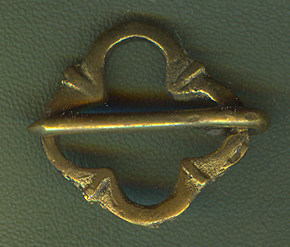 |
Quatrefoil Ring Brooch: A fine brass ring brooch found in
London. England, Late 14th or 15th Century. It was cast from an
original in our private collection. 1 inch wide central opening. $15.00
in brass (Replica Collection)
|
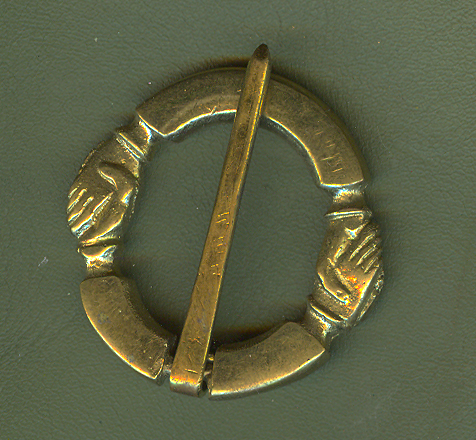 |
Bethrothal Brooch: A brass ring brooch in the form to
two pairs of clasped hanfs. These are frequently referred to as Fede
Brooches or as Hanntruwebrachen. Broches of
this sort, because of their form were common betrothal presents.
Base on an example in Westfallisches Landesmuseum, in Munster,
Germany. Hundreds of examples this form of brooch survive. They
appear to have been common throughout Europe. In Ireland they gave
rise to the claddaigh ring. These brooches were especially
popular in the 14th century. 1 1 1/4 inch wide central opening. $15.00
in brass (Replica Collection)
|
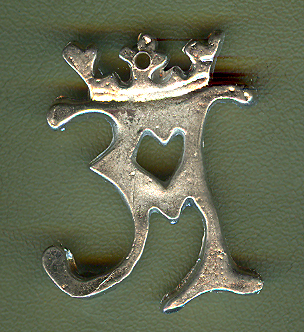 |
Pewter Crowned A Pendant: The literate nobility of the
High Middle Ages were very fond of word play. Besides puns and
poetry, the anagram was a popular motif for jewelry and personal
adornment. Even Chaucer's nun in the Canterbury Tales sports a
brooch in the form of a crowned A. This particular symbol is an
anagram for Amor Vincit Omnia (Love Conquers All.) It is based on
a surviving pendant in the Guildhall Museum in London. $5.00 in
pewter.
|
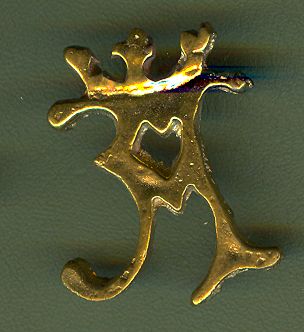 |
Brass Crowned A Pendant: The literate nobility of the
High Middle Ages were very fond of word play. Besides puns and
poetry, the anagram was a popular motif for jewelry and personal
adornment. Even Chaucer's nun in the Canterbury Tales sports a
brooch in the form of a crowned A. This particular symbol is an
anagram for Amor Vincit Omnia (Love Conquers All.) It is based on
a surviving pendant in the Guildhall Museum in London. $20.00
in brass.
|
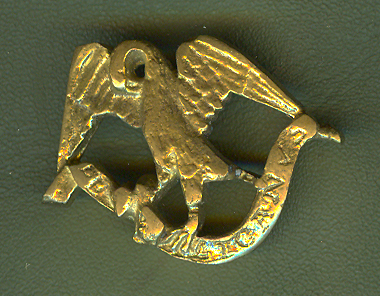 |
Pelican Pendant: The pelican is the noblest of all God's
creatures. In the medieval period the pelican was believed, in
times of hardship, to open her own breast and feed her young from
her own blood. The pelican was a popular medieval symbol, and was
frequently used to represent Christ's sacrifice on the cross. This
excellent pelican medallion is modeled after the surviving example
in the Victoria and Albert Museum. The original dates from the
late 14th century and has a ruby set as the drop of blood over
it's heart. $25.00 in brass.
|
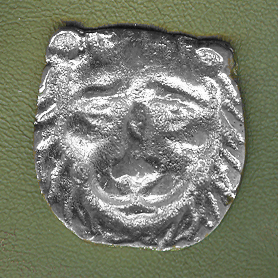 |
Pewter Lion Pendant: This brass pendant was cast from
an original belt plaque in our private collection. It has been
presented as a pendant. Spanish, 14th century. $5.00 in pewter
(Replica Collection)
|
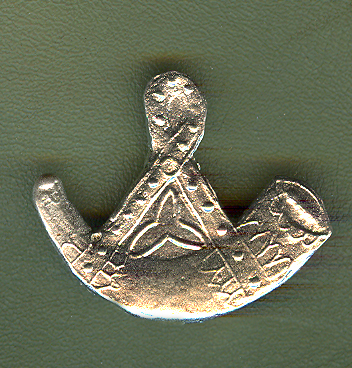 |
The Hunting Horn of St. Hubert: This 14th century pendant
was made in honor of St. Hubert , who while hunting one day, saw a
cross appear between the antlers of a stag. His emblems have
always been associated with hunting. This badge was also used by
huntsmen and also by several noble households. $5.00 in pewter
|
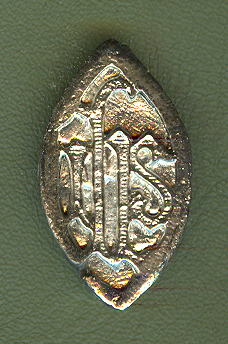 |
IHS Pendant: IHS was an important medieval religious
anagram for Iesus Hominum Salvator, (Jesus Savior of Man). It is
copied from an original badge in our private collection. 14th-
15th century English. $5.00 in pewter (Replica
Collection)
|
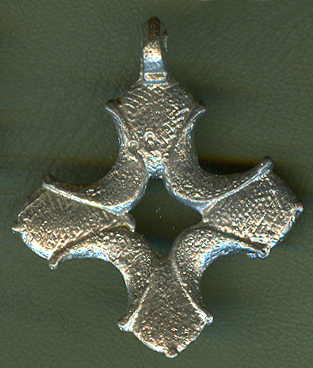 |
Large Cross Pendant: This large pewter cross is a
replica of an original bronze cross in our private collection. The
original was probably a pendant from horse harness trappings
though similar examples were certainly worn by people. 13th-15th
century English. $6.00 in pewter (Replica Collection)
|
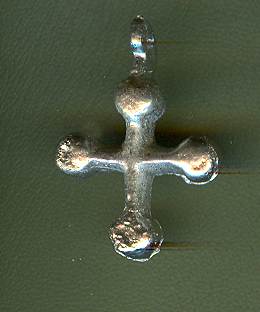 |
Small Cross Pendant: This small pewter cross is a
replica of an original bronze cross in our private collection. The
original was probably a pendant from horse harness trappings
though similar examples were certainly worn by people. 13th-15th
century English. $3.00 in pewter (Replica Collection)
|
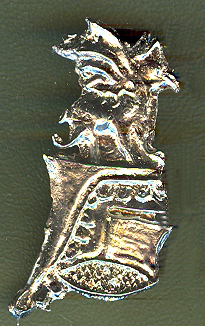 |
Edward III Griffon Badge: The griffon was one of the
favorite emblems of King Edward III. Badges of this sort would
have been worn by supporters of the king. This badge featuring a
griffon crest seated atop a mantled great helm is based on
Mitchner #299. Integral pin. $5.00 in pewter
|
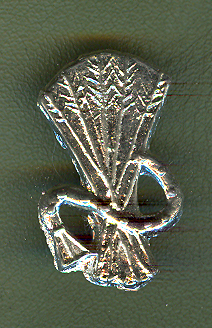 |
Bury St. Edmund's Badge: A badge in the form of a sheaf
of arrows bundled with a belt. Based on an example in the
Salisbury and South Wiltshire Museum. $5.00 in pewter
|
 |
Greyhound Badge: A sporting badge for greyhound coursing.
This badge features a greyhound seemingly unaware of the hare
standing between his legs. Based on an example in the Salisbury
and South Wiltshire Museum. $5.00 in pewter
|
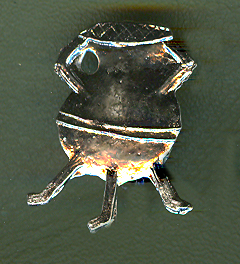 |
Cauldron Badge: A badge in the form of a medieval
cauldron. Based on an example in the Museum Boijmans Van
Beuningen, in Rotterdam. $5.00 in pewter.
|
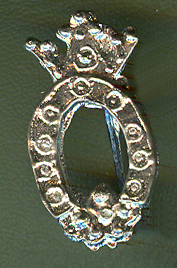 |
Crowned Horseshoe Badge: A badge in the form of a
horseshoe capped wih a crown and with a rose at the foot. Based on
an example in the Museum Boijmans Van Beuningen, in Rotterdam. $5.00
in pewter.
|
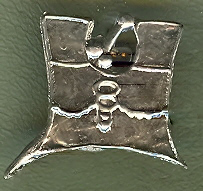 |
Purse and Dagger Badge: A badge in the form of a
phallic "ballock dagger" worn stuck through a purse. It is thought
to be a sexual reference and may also have been poking fun at
devout pilgrims and their religious badges. Based on an example in
the Museum Boijmans Van Beuningen, in Rotterdam. $5.00 in
pewter.
|
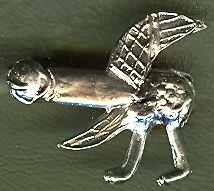 |
Winged Phallus Badge: A badge in the form of a winged
phallus. Based on an numerous examples including one in our
private collection. The motif of a winged phallus dates back at
least as far as Roman times. It is thought to be a symbol of
fertility and may also have been poking fun at devout pilgrims and
their religious badges . $5.00 in pewter.
|
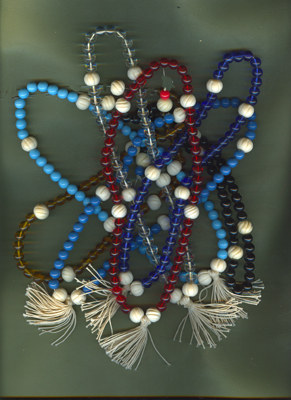 |
Paternoster beads: Paternosters were indispensable for
people of all classes in the middle ages. They were used by the
pious to count their daily prayers. Virtually everyone in the
middle ages owned at least one. For the pious they were used as
devotional tools. For the less devout they were symbols of that
which they wished others to believe about them. These fine,
handmade, period paternosters are absolutely accurate down to the
materials used and the methods of construction. They are
constructed by taking fifty handmade beads of either opaque black,
red, blue, translucent red, translucent amber, translucent greeen,
translucent blue, translucent purple, or clear glass (all produced
by hand without the use of power tools) and strung in groups of
ten spaced with handmade bone gauds (marker beads) and finished
with a with a linen tassel. Please specify a color. These gauds
are also produced without the benefit of power tools. The glass
and bone paternoster is particularly authentic as both were
extremely popular materials for use in the construction of
paternosters. In fact in 1365, Magnavia, Bishop of Orvieto, a high
papal official, left at his death "a cord of paternosters of glass
and whitebone.". $20.00
|